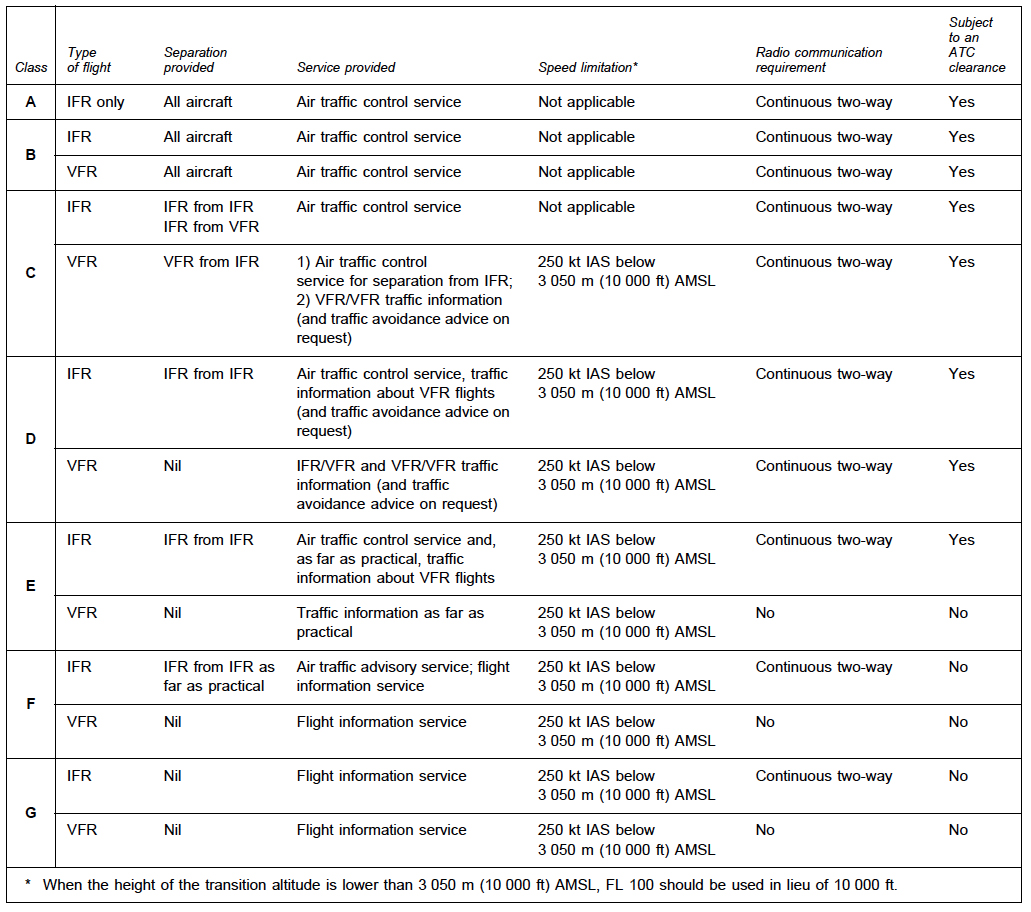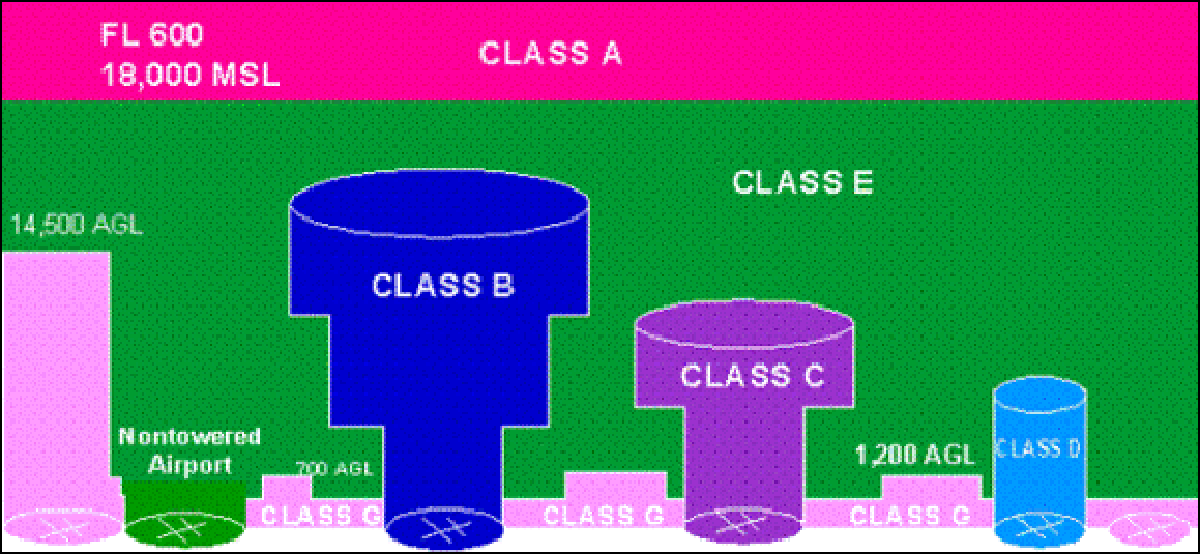Here's a pop quiz for you . . . Who was the most famous Class-B violator of all time? Back then it was called a Terminal Control Area (TCA) and the guy who done it was Larry Walters. He strapped 42 weather balloons to his lawn chair and flew for two hours as high as 16,000 feet. When all was said and done, the FAA fined him $4,000 for violating the Los Angeles TCA. He plea bargained the fine to $1,500. (News article printed below.)
— James Albright

Updated:
2020-12-12
As an instrument pilot dedicated to always filing an IFR flight plan, airspace classification may not be your most critical issue. Knowing airspace classification, however, can come in handy now and then and can keep you from a violation. More about that: Class B Woes.
Ever wonder why the U.S. classification method changed a few years back? Look at the ICAO definitions and find out.

1
ICAO airspace

Airspace Classification (ICAO Annex 11, Air Traffic Services, Appendix 4)
ATS airspaces shall be classified:
- Class A. IFR flights only are permitted, all flights are provided with air traffic control service and are separated from each other.
- Class B. IFR and VFR flights are permitted, all flights are provided with air traffic control service and are separated from each other.
- Class C. IFR and VFR flights are permitted, all flights are provided with air traffic control service and IFR flights are separated from other IFR flights and from VFR flights. VFR flights are separated from IFR flights and receive traffic information in respect of other VFR flights.
- Class D. IFR and VFR flights are permitted and all flights are provided with air traffic control service, IFR flights are separated from other IFR flights and receive traffic information in respect of VFR flights, VFR flights receive traffic information in respect of all other flights.
- Class E. IFR and VFR flights are permitted, IFR flights are provided with air traffic control service and are separated from other IFR flights. All flights receive traffic information as far as is practical. Class E shall not be used for control zones.
- Class F. IFR and VFR flights are permitted, all participating IFR flights receive an air traffic advisory service and all flights receive flight information service if requested.
- Class G. IFR and VFR flights are permitted and receive flight information service if requested.
Note.— Where air traffic advisory service is implemented, this is considered normally as a temporary measure only until such time as it can be replaced by air traffic control. (See also PANS-ATM, Chapter 9.)
Source: ICAO Annex 11, Air Traffic Services §2.6.1
2
U.S. FAA

Airspace Classes (Aeronautical Information Manual, ¶3-2-1, Figure 3-2-1.)
Class A Airspace
The airspace descriptions contained in § 71.33 and the routes contained in subpart A of FAA Order 7400.9W (incorporated by reference, see § 71.1) are designated as Class A airspace within which all pilots and aircraft are subject to the rating requirements, operating rules, and equipment requirements of part 91 of this chapter.
Source: 14 CFR 71 §71.31
(a) That airspace of the United States, including that airspace overlying the waters within 12 nautical miles of the coast of the 48 contiguous States, from 18,000 feet MSL to and including FL600 excluding the states of Alaska and Hawaii, Santa Barbara Island, Farallon Island, and the airspace south of latitude 25°04′00″ North.
(b) That airspace of the State of Alaska, including that airspace overlying the waters within 12 nautical miles of the coast, from 18,000 feet MSL to and including FL600 but not including the airspace less than 1,500 feet above the surface of the earth and the Alaska Peninsula west of longitude 160°00′00″ West.
(c) The airspace areas listed as offshore airspace areas in subpart A of FAA Order 7400.9W (incorporated by reference, see § 71.1) that are designated in international airspace within areas of domestic radio navigational signal or ATC radar coverage, and within which domestic ATC procedures are applied.
Source: 14 CFR 71 §71.33
Generally, from FL180 up to and including FL 600, including over waters within 12 nm of the coast of the CONUS and Alaska. Unless otherwise authorized, all persons must operate their aircraft under IFR.
Class B Airspace
The Class B airspace areas listed in subpart B of FAA Order 7400.9W (incorporated by reference, see § 71.1) consist of specified airspace within which all aircraft operators are subject to the minimum pilot qualification requirements, operating rules, and aircraft equipment requirements of part 91 of this chapter. Each Class B airspace area designated for an airport in subpart B of FAA Order 7400.9W (incorporated by reference, see § 71.1) contains at least one primary airport around which the airspace is designated.
Source: 14 CFR 71 §71.41
Generally, surface to 10,000 feet MSL surrounding the nation's busiest airports. Individually designed to contain all published instrument procedures. ATC clearance is required and all aircraft that are so cleared receive separation services within the airspace.
Class C Airspace
The Class C airspace areas listed in subpart C of FAA Order 7400.9W (incorporated by reference, see § 71.1) consist of specified airspace within which all aircraft operators are subject to operating rules and equipment requirements specified in part 91 of this chapter. Each Class C airspace area designated for an airport in subpart C of FAA Order 7400.9W (incorporated by reference, see § 71.1) contains at least one primary airport around which the airspace is designated.
Source: 14 CFR 71 §71.51
Generally, surface to 4,000 feet above the airport elevation surrounding airports with operational control towers served by a radar approach control. Usually consists of a surface area with a 5 nm radius and an outer circle with a 10nm radius that extends from 1,200 feet to 4,000 feet above the airport elevation. Must establish and maintain 2-way radio communications with the ATC facility prior to entering the airspace. VFR aircraft separated from IFR aircraft within the airspace.
Class D Airspace
The Class D airspace areas listed in subpart D of FAA Order 7400.9W (incorporated by reference, see § 71.1) consist of specified airspace within which all aircraft operators are subject to operating rules and equipment requirements specified in part 91 of this chapter. Each Class D airspace area designated for an airport in subpart D of FAA Order 7400.9W (incorporated by reference, see § 71.1) contains at least one primary airport around which the airspace is designated.
Source: 14 CFR 71 §71.61
Generally, surface to 2,500 feet above the airport elevation surrounding airports with operational control towers. Normally contains the instrument procedures. Arrival extensions for instrument approach procedures may be Class D or Class E airspace. Unless otherwise authorized, must establish and maintain 2-way radio communications with the ATC facility providing air traffic services prior to entering the airspace. No separation services are provided to VFR aircraft.
Class E Airspace
(a) The airspace of the United States, including that airspace overlying the waters within 12 nautical miles of the coast of the 48 contiguous states and Alaska, extending upward from 14,500 feet MSL up to, but not including 18,000 feet MSL, and the airspace above FL600, excluding—
(1) The Alaska peninsula west of longitude 160°00′00″ W.; and
(2) The airspace below 1,500 feet above the surface of the earth.
(b) The airspace areas designated for an airport in subpart E of FAA Order 7400.9W (incorporated by reference, see § 71.1) within which all aircraft operators are subject to the operating rules specified in part 91 of this chapter.
(c) The airspace areas listed as domestic airspace areas in subpart E of FAA Order 7400.9W (incorporated by reference, see § 71.1) which extend upward from 700 feet or more above the surface of the earth when designated in conjunction with an airport for which an approved instrument approach procedure has been prescribed, or from 1,200 feet or more above the surface of the earth for the purpose of transitioning to or from the terminal or en route environment. When such areas are designated in conjunction with airways or routes, the extent of such designation has the lateral extent identical to that of a Federal airway and extends upward from 1,200 feet or higher. Unless otherwise specified, the airspace areas in the paragraph extend upward from 1,200 feet or higher above the surface to, but not including, 14,500 feet MSL.
(d) The Federal airways described in subpart E of FAA Order 7400.9W (incorporated by reference, see § 71.1).
(e) The airspace areas listed as en route domestic airspace areas in subpart E of FAA Order 7400.9W (incorporated by reference, see § 71.1). Unless otherwise specified, each airspace area has a lateral extent identical to that of a Federal airway and extends upward from 1,200 feet above the surface of the earth to the overlying or adjacent controlled airspace.
(f) The airspace areas listed as offshore airspace areas in subpart E of FAA Order 7400.9W (incorporated by reference, see § 71.1) that are designated in international airspace within areas of domestic radio navigational signal or ATC radar coverage, and within which domestic ATC procedures are applied. Unless otherwise specified, each airspace area extends upward from a specified altitude up to, but not including, 18,000 feet MSL.
Source: 14 CFR 71 §71.71
Generally, all other controlled airspace. Extends from surface or a designated altitude to the overlying or adjacent controlled airspace. Also in this class are Federal airways, airspace beginning at either 700 or 1,200 feet AGL used to transition to/from the terminal or en route environment, en route domestic, and offshore airspace areas designated below 18,000 feet MSL. Unless designated at a lower altitude, begins at 14,500 MSL.
Class G Airspace
Class G airspace (uncontrolled) is that portion of airspace that has not been designated as Class A, Class B, Class C, Class D, or Class E airspace.
Source: Aeronautical Information Manual ¶3-3-1.
Flight Visibility / Distance from Clouds

Basic VFR Minimums (Aeronautical Information Manual, ¶3-1-5, Tbl 3-1-1)
Rules governing VFR flight have been adopted to assist the pilot in meeting the responsibility to see and avoid other aircraft. Minimum flight visibility and distance from clouds required for VFR flight are contained in 14 CFR Section 91.155.
Source: Aeronautical Information Manual ¶3-3-2.
Title 14 CFR specifies the pilot and aircraft equipment requirements for IFR flight. Pilots are reminded that in addition to altitude or flight level requirements, 14 CFR Section 91.177 includes a requirement to remain at least 1,000 feet (2,000 feet in designated mountainous terrain) above the highest obstacle within a horizontal distance of 4 nautical miles from the course to be flown.
Source: Aeronautical Information Manual ¶3-3-3.a.
References
(Source material)
14 CFR 71, Title 14: Aeronautics and Space, Designation of Class A, B, C, D, and E Airspace Areas; Air Traffic Service Routes, and Reporting Points, Federal Aviation Administration, Department of Transportation
Aeronautical Information Manual
ICAO Annex 11 - Air Traffic Services, International Standards, Annex 11 to the Convention on International Civil Aviation, Fifteenth Edition, July 2018
